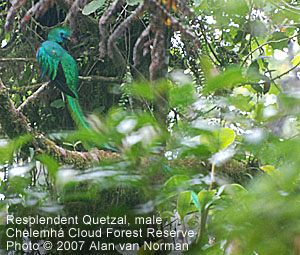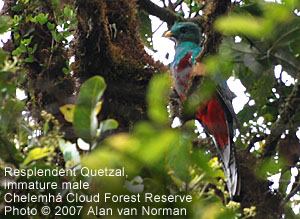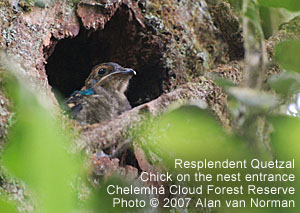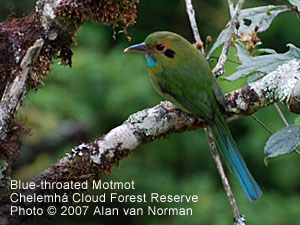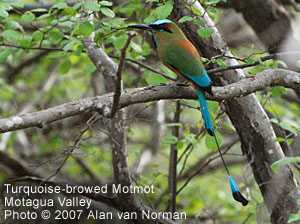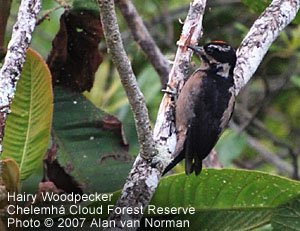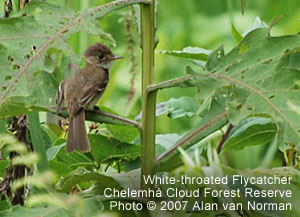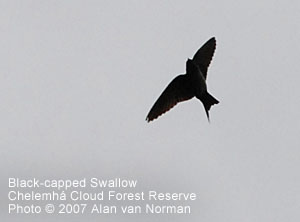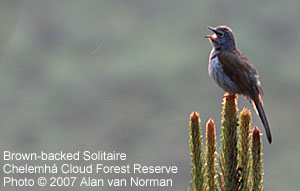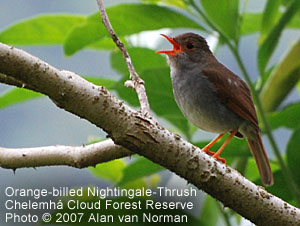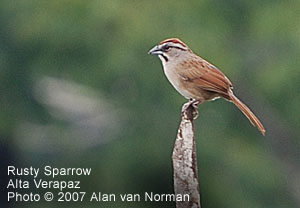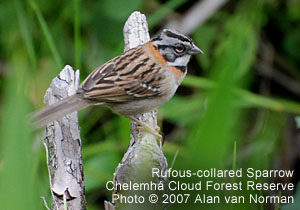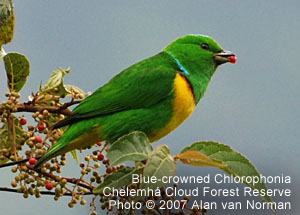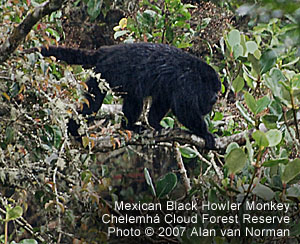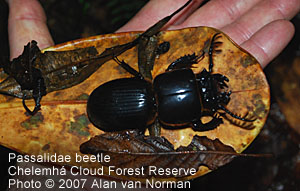Trip Report: Customized Birding Tour (25-29 May 2007)
by Alan van Norman
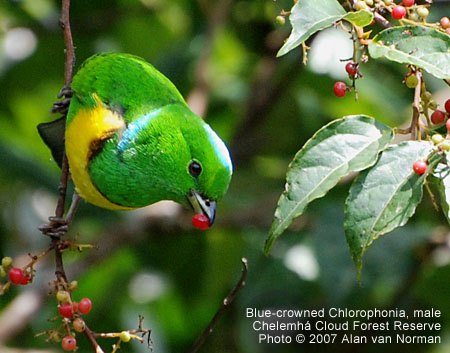
In 2005, my wife and I went to Guatemala on holiday for a week in November. During that trip, we arranged a 3 day birding trip with Cayaya Birding to look for the Horned Guan. We had a very successful (albeit very strenuous) hike up the side of Volcano Atitlan, the highlight of which was prolonged looks at two Horned Guans looking back at us. I was very impressed with everything about Knut Eisermann, co-owner, chief cook and bottle washer for Cayaya Birding. He is a brilliant field ornithologist, a great logistician and an all-around very pleasant fellow (see below). Thus when business took me back to Guatemala in May 2007, I pre-arranged a 5 day trip with Knut once again. My goal this time was to look for Resplendent Quetzals and look for highland rainforest owls.
LOGISTICS AND ITINERARY
I flew American Airlines evening flight from Miami to Guatemala City. Knut's wife Claudia had arranged hotel reservations for me at Hotel Stofella (a Best Western hotel) in Guatemala City. I caught a taxi there (very easy - cost $8 USD). Knut arrived at the hotel to pick me up at 05:50. The agreed on time had been 06:00. He had a new 4WD rental vehicle already packed with all our provisions. We then drove to Chelemha Lodge high in the Yalijux mountains. The drive normally takes about 6 hours Knut said but road construction held us up getting out of Guatemala City and it took us almost 8 hours. The last 50 kilometers or so is unpaved. The last 2 or 3 kilometers is actually nothing more than a cow trail or foot path. I think the only motorized vehicle that ever uses it is whatever Knut is driving on his monthly visits here for bird monitoring. We spent that afternoon, the next 3 days, and a final morning here. We then drove back to Guatemala City with stops at a restaurant next to the Quetzal Biotope Reserve and in Motagua Valley. Knut dropped me off at my hotel at about 21:00 for a quick wash-up, then he and Claudia picked me up again at 21:45 and we went to a nice restaurant for dinner. The next 5 days I spent doing business related things, arriving back at Guatemala airport at about 14:00 on 4 June. Claudia picked me up at the airport and took me to another site just outside Antigua where we birded the remainder of daylight before she took me back to hotel Stofella. I returned home on American Airlines via Dallas Fort Worth early the next morning.
CAYAYA BIRDING, KNUT EISERMANN AND CLAUDIA AVENDAÑO
Please check out the Cayaya Birding website for more information: www.cayaya-birding.com. Knut and Claudia are both quite modest however and the actual depth of their birding skills, the ethics of their birding and their ecologic commitments are all underplayed on their website.
Knut is really an extraordinary birder. He has developed a bird monitoring technique that employs locals and relies on bird identification by call alone. It is non-invasive, reproducible and far more accurate and inclusive than sight recording, mist-netting or playback. Knut by the way almost never uses playback. Don't ask him to. It is his firm belief that playback or using birdcall recordings is disruptive to and stressful for the birds. He likens it to someone coming up to your house, knocking on the door and announcing it was their house and no longer yours. At a minimum it would be annoying. Imagine if it happened every day. It may take him a little longer to find the birds for you than the bird tour groups that habitually use tapes. However he will find them and you will have the satisfaction of knowing that the birds only feel they have to hide from you and not that they are being invaded by pushy, possessive neighbors. Knut has spent over ten years birding by ear in Guatemala. His hearing is phenomenal and his knowledge of bird vocalizations is also similarly remarkable. Yes, he is one of those people who can identify a hummingbird by call at over thirty feet amidst the cacophony of the morning chorus. Also note that Knut has spent the last 10 years tromping up and down mountain trails pre-dawn to after dark and he has long legs and was a competitive bicyclist before coming to Guatemala. He usually does his bird monitoring either alone or with a local native Qeqchi. He is tireless. You may need to remind him on occasion that you have one of the common human limitations such as short legs, bad joints, a desk job or that you are carrying 50 extra pounds around your waist. He will happily slow his pace for your, but it is not what he is accustomed to. Claudia is also a very accomplished birder. Unfortunately for her however she was quite limited culturally by being female in a Latin American country. As a single young woman, she simply didn't have the freedom to wander alone in the forest that Knut did. Since marrying Knut, she has spent much more time in the forest and has made several important studies and discoveries on her own. She also naturally walks at a pace more similar to ordinary humans.
As a married couple and as a company, Knut and Claudia are deeply committed to birds, the local ecology, the local Qeqchi people and the local economy. Their focus is to make bird tourism the best it can be for all parties involved, that is the forest, the birds, the local indigenous people and the visiting birder. When you take a trip with Cayaya Birding, part of your fee goes to sustaining the forest and all that goes along with it.
CHELEMHÁ CLOUD FOREST LODGE
This is one of those magical places. It is run by Armin (a Swiss ex-pat) and his Qeqchi wife Elvira. They live in a traditional Qeqchi house across the valley. The lodge is out of hearing distance from any roadway, telecommunications or machinery. There is no electricity here. However, they do have hot showers and flush toilets. It is wonderfully quiet and secluded but with a wonderful view. But the best part is Armin's cooking. He is an exceptional chef. The amazing thing is that it is all cooked right in front of you on a wood burning stove. Most of the food is either grown on the premises or harvested from the forest. Beef or fish are brought in from the valley and kept in a cellar. Otherwise I think everything we ate was picked or harvested the day we ate it. Birding starts right on the deck with the morning coffee and also ends on the deck with the evening glass of wine.
ANNOTATED BIRD LIST
In the 3 days in the cloud forest, the drive back and the short afternoon, we saw just over 100 species. We missed one afternoon's birding for heavy rain. I am a very, very amateur photographer. We spent a fair bit of time photographing birds. Please see photos.
HIGHLAND GUAN: Quite common at Chelemha. We saw them almost every venture into the forest. They are very shy however and very difficult to see well. Knut knew of 3 active nests along the trail and with careful approach, we sometimes were able to see the hen sitting on the nest before she flushed. These were all nests within a few feet of the trail and there was no way to use the trail without flushing the bird. They make quite a racket and are one of the common sounds of the Chelemha cloud forest. They were decidedly difficult to photograph.
BUFFY-CROWNED WOOD-PARTRIDGE: These are also quite common but similarly very difficult to see. They inhabit the heavy brush that borders the older milpas. We heard them often but only saw one for a short while through the scope as it worked its way across the milpa on the other side of the valley.
GREEN HERON: Heard only. Motagua Valley.
BLACK AND TURKEY VULTURES: Common on the drive to and from Chelemha.
HOOK-BILLED KITE: One dark morph individual flew over the ridge and soared for a brief while at Chelemha.
WHITE-BREASTED HAWK: (a recent split from Sharp-shinned Hawk). One individual was seen briefly flying through the forest below the canopy near the lodge. Another was seen hunting on top of the ridge. It later perched in the open on top of the ridge for a nice photo op.
BAND-TAILED PIGEON: Seen daily in small numbers from the lodge veranda.
WHITE-WINGED, INCA AND RUDDY-GROUND DOVES: Seen en route to and from Chelemha.
WHITE-FACED QUAIL-DOVE: Heard on several occasions and flushed once from the trail at Chelemha.
BARRED PARAKEET: Heard once flying over while on the ridge top at Chelemha.
PACIFIC PARAKEET: Pair seen perched and flying at Motagua Valley.
SQUIRREL CUCKOO: Single seen on the drive down from Chelemha.
LESSER ROADRUNNER: One seen well and photographed at Motagua Valley.
GROOVE-BILLED ANI: Several seen en route back from Chelemha.
GUATEMALAN PYGMY-OWL: This was the one occasion when Knut broke down. He once whistled the call of this owl in the forest when he knew there was none about but that it might bring in a hunting Fulvous Owl. He also played the tape once down in the valley where he'd heard a Pygmy-Owl calling the night before. He played the call only for a few seconds. We heard a bird respond up the hillside and he turned off the tape. The bird continued to call and he found it in a flashlight beam after a few minutes. We heard it calling several times during the 3 days at Chelemha. It was a distant view of the bird in a flashlight beam, mostly eye-shine. But we could see it calling and the call was what is crucial to identification.
FERRUGINOUS PYGMY-OWL: One seen well at close range in Motagua Valley.
FULVOUS OWL: Knut had found once in the past that when he whistled the call of the Pygmy-Owl, that a Fulvous Owl came in to investigate. He tried this for me at the same location. A Fulvous Owl came in and perched directly overhead, allowing for photos with flash. It soon lost interest in us but kept hunting for the Pygmy-Owl as it scanned the forest from its perch just off the trail.
LESSER NIGHTHAWK: Seen giving courtship display at Motagua Valley.
MEXICAN WHIP-POOR-WILL: Heard and seen briefly at site just outside Antigua.
CHESTNUT-COLLARED SWIFT: A small group seen flying along the ridge top from the Wine-throated Hummingbird lek.
WHITE-THROATED SWIFT: Single seen with the previous species.
VIOLET SABERWING: A single was seen briefly as it came to inspect feeders at Chelemha. Also at site near Antigua.
RUFOUS SABERWING: Several seen at coming to feeders at site near Antigua.
WHITE-EARED HUMMINGBIRD: One of the most common visitors to the feeders at Chelemha. Also seen at site outside Antigua.
AZURE-CROWNED HUMMINGBIRD: One seen at the restaurant near Biotope Quetzal and also seen at feeders outside Antigua.
GREEN-THROATED MOUNTAIN GEM: Heard at Chelemha and one seen at restaurant near Biotope Quetzal.
AMETHYST-THROATED HUMMINGBIRD: Frequently seen at feeders at Chelemha but dominated by Garnet-throated Hummingbirds.
GARNET-THROATED HUMMINGBIRD: Dominant hummingbird at Chelemha feeders.
MAGNIFICENT HUMMINGBIRD: Common at Chelemha feeders.
WINE-THROATED HUMMINGBIRD: Single male seen several times at lek on ridge top at Chelemha.
MOUNTAIN TROGON: One of the most common sounds of Chelemha. We unfortunately had nothing more than several flight views.
RESPLENDANT QUETZAL: (Pharomachrus mocinno mocinno) This was the main reason I wanted to go to Chelemha. We had a total of over 30 sightings of this species in the 3 days. My photos do not do justice to the magnificence of this bird. At one point we had 7 adults including several breeding plumage males feeding in the trees above us. Knut also took me to a nest tree he had been watching. Much to our delight a chick was sitting in the nest hole, looking back at us. If you ever want to see a Resplendent Quetzal this is the place. You will definitely see them here. Also it should be noted these are the longer tailed subspecies. We saw some with tails nearly a meter long. I had also seen Quetzals in Costa Rica. These birds definitely have much longer tails and are definitely more spectacular than the subspecies of Costa Rica and Panama.
BLUE-THROATED MOTMOT: Seen daily from the lodge veranda.
RUSSET-CROWNED MOTMOT: We looked for this at Motagua Valley and heard one several times. We circled one in a thicket but were never able to actually lay eyes on it.
TURQUOISE-BROWED MOTMOT: This bird was common at Motagua. We found 8 or 10 of them while looking for the Russet-crowned Motmot.
GREEN KINGFISHER: A single male was fishing at the pools at the site near Antigua.
EMERAL TOUCANET: We heard this bird several different times at Chelemha but didn't see it.
ACORN WOODPECKER: Several seen on the return from Chelemha.
GOLDEN-FRONTED WOODPECKER: Common in Motagua Valley.
HAIRY WOODPECKER: (sanctorum subspecies) This bird was seen regularly from the veranda at Chelemha and heard occasionally as well. This is the distinctive Central American Highland subspecies. See photos. It is markedly different than the Hairy Woodpeckers in my yard in North Dakota.
NORTHERN (GUATEMALAN) FLICKER: (Colaptes auratus mexicanoides) Several of this distinctive subspecies were seen around the lodge.
RUDDY FOLIAGE-GLEANER: A pair of these had just finished fledging young from a nest hole less than 5 meters from the lodge door. They were last seen, unfortunately not by me, the morning before I arrived. We did happen upon a pair feeding busily while we were looking for Quetzals near the ridge top.
TAWNY-THROATED LEAFTOSSER: One scolded us vigorously while we were trying to pin down a Mountain Trogon. I saw it only briefly as it hopped about in the brush. We heard it also several more times.
SPOT-CROWNED WOODCREEPER: This is the common woodcreeper of the Chelemha forests, though I think we only saw one individual.
YELLOW-BELLIED ELAENIA: One bird was found in the valley below Chelemha as we were looking for the White-throated Flycatcher.
MOUNTAIN ELAENIA: Another common bird of the highland forests. We heard them often and saw them almost daily from the veranda.
PALTRY TYRANNULET: This was a bird I spent little time on. We saw one and heard one and I then I stopped paying attention to them. There may have been more.
TUFTED FLYCATCHER: We heard one quite near the lodge. We tried to track it down but without success.
WHITE-THROATED FLYCATCHER: One of the dreaded Empidonax clan but for all that rather distinctive and easy to identify. Knut knew of a territory in the valley below Chelemha and took me there twice. A single calling individual was present on both occasions, calling and hunting.
YELLOWISH FLYCATCHER: Another of the dreaded Empidonax gang but even more distinctive and easy to identify than the previous species. This is the common breeding Empidonax of these highland forests and we saw them nearly daily.
BLACK PHOEBE: A single seen over the river at Motagua Valley.
GREAT KISKADEE: Single bird seen in Motagua Valley.
BOAT-BILLED FLYCATCHER: Single bird seen in Motagua Valley.
TROPICAL KINGBIRD: A few seen en route from Chelemha back to Guatemala City.
HUTTON'S AND BROWN-CAPPED VIREOS: Knut called my attention to the calls of these two vireos though we never saw either.
BROWN JAY: A single was seen on the return to Guatemala City.
BUSHY-CRESTED JAY: A common bird around the lodge where they were seen foraging daily.
BLACK-THROATED JAY: This is a bird of the interior highland forest. We heard several flocks and tracked them down. I struggled largely without success for a decent photo. We saw over 10 individuals all counted.
BLACK-CAPPED SWALLOW: Seen daily foraging in the valley in front of the lodge. They nest close by.
PLAIN WREN: Several were seen in the valley in front of the lodge on the last day as we looked for Rusty Sparrow and White-throated Flycatcher.
SOUTHERN HOUSE WREN: Heard occasionally in the vicinity of the lodge though we didn't seek out this species. Several were seen in the valley.
RUFOUS-BROWED WREN: Several were seen in the cloud forest above the lodge. More often heard than seen.
GRAY-BREASTED WOOD WREN: This also was a bird much more often heard than seen though we saw an individual on several occasions.
EASTERN BLUEBIRD: A family, male, female and two fledged young, were seen in the valley as we looked for Rusty Sparrow.
BROWN-BACKED SOLITAIRE: Seen and heard daily around the lodge. Several pairs nested along the trail. One nest right at the trails edge had downy young in it.
SLATE COLORED SOLITRAIRE: We heard this bird daily. Only once were we able to track down a singing male.
ORANGE-BILLED NIGHTINGALE-THRUSH: Several pairs had territories near the lodge. I had nice opportunity to photograph one in the lodge garden. Seen daily.
RUDDY-CAPPED NIGHTINGALE-THRUSH: Also seen daily, but generally in the forest rather than around the lodge.
BLACK ROBIN: Seen daily around the lodge.
MOUNTAIN ROBIN: A common bird both around the lodge and in the forest.
CLAY-COLORED ROBIN: A common bird in the valley below the lodge.
RUFOUS-COLLARED ROBIN: Seen only once or twice in the valley just below the lodge.
TROPICAL MOCKINGBIRD: Common in Motagua Valley.
BLUE-AND-WHITE MOCKINGBIRD: Initially Knut struggled to show me this bird. He would see it and I would miss it or it would be quite distant. Eventually a pair showed nicely by the lodge. Later as we left we had a pair very close up along the road just below the lodge.
CRESCENT-CHESTED WARBLER: We heard this bird daily in the forest though saw one foraging in the canopy only once. We didn't actually spend much time looking for this bird though.
WILSON'S WARBLER: Knut heard one call while we were along the ridge top and commented that these were extremely common in winter but that there were no summer records of this species at Chelemha.
SLATE-THROATED REDSTART: This was probably the most common warbler seen, both in the forest and around the lodge.
GOLDEN-BROWED WARBLER: This little gem also nested right along the trail. It tended to sit tight though and allow very close approach allowing for some nice photos. It was also seen frequently in the forest.
COMMON BUSH TANAGER: This is the most common tanager in the highlands around Chelemha and was seen daily.
FLAME-COLORED TANAGER: We saw this bird just a few times around the lodge.
WHITE-COLLARED SEED-EATER: Seen in small numbers around the lodge and in the valley daily.
YELLOW-FACED GRASSQUIT: Also seen in small numbers around the lodge and in the valley daily.
CINNAMON-BELLIED FLOWER-PIERCER: Seen daily around the lodge and in the forest.
WHITE-NAPED BRUSH-FINCH: Seen daily around the lodge and in the forest.
CHESTNUT-CAPPED BRUSH-FINCH: Seen daily around the lodge and in the forest.
PREVOST'S GROUND-SPARROW: Several seen in the garden around the lodge but it tended to be quite shy.
WHITE-EARED GROUND-SPARROW: A single male was seen at the site outside Antigua.
STRIPE-HEADED SPARROW: One seen in Motagua Valley.
RUSTY SPARROW: We struggled to find this bird on the way down out of the valley. We tried several sites before finally finding one. Then as we were leaving the valley, we found a nice specimen sitting out in the open singing.
RUFOUS-COLLARED SPARROW: One of the ubiquitous birds of disturbed areas in the highlands.
GRAYISH SALTATOR: We saw one pair of birds in the garden below the lodge.
BLACK-HEADED SALTATOR: We saw a single bird from the lodge veranda on one occasion.
MELODIOUS BLACKBIRD: A common inhabitant of the brushy areas below the lodge.
GREAT-TAILED GRACKLE: Common lower down around human habitation.
BRONZED COWBIRD: A few were seen in Motagua Valley and along the road on the way down out of the mountains.
BLACK-VENTED ORIOLE: A single bird was seen at the site outside Antigua as we looked for Bar-winged Oriole.
ALTIMIRA ORIOLE: Several were seen in Motagua Valley.
STREAK-BACKED ORIOLE: Several of these were also seen in Motagua Valley.
YELLOW-BILLED CACIQUE: Heard occasionally in the valley below the lodge but not seen. This is quite a shy bird and probably could have been found had we made an effort to locate it.
BLUE-CROWNED CHLOROPHONIA: This was one of the prizes of the trip. A pair
fed in a tree on a slope below the trail such that they were at eye level
to us only about 15 meters away allowing for great photos. We also heard them
often in the forest but they were nearly impossible to see there as they tended
to stay high in the canopy.
Alan van Norman, Bismarck, North Dakota, USA.


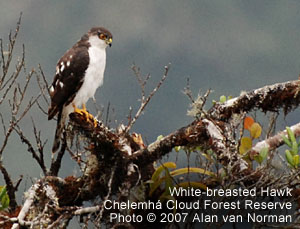
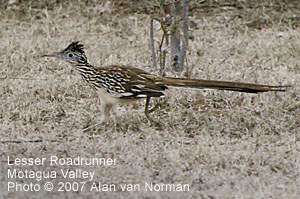
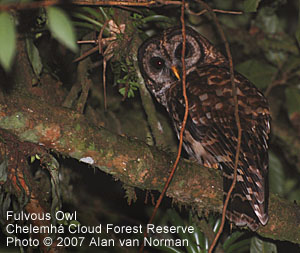
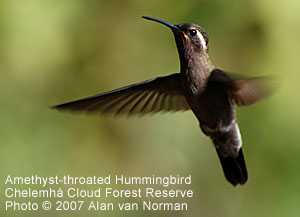
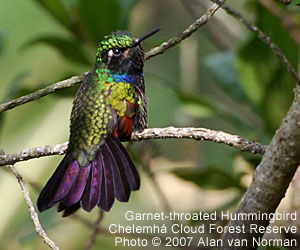
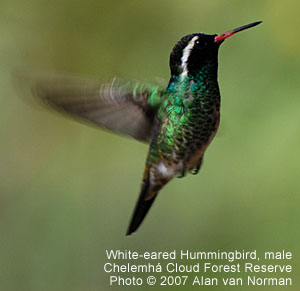
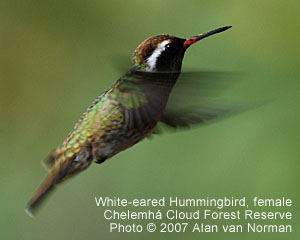
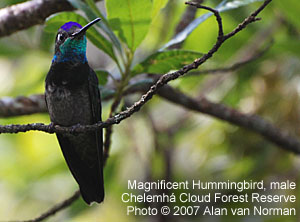
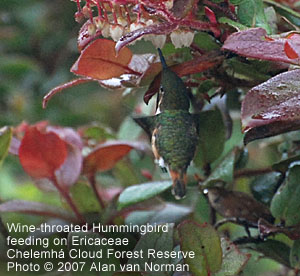 Wine-throated Hummingbird
Wine-throated Hummingbird